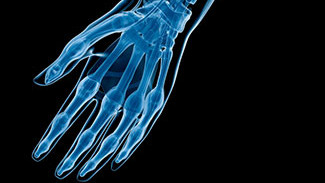 The thumb is not just another finger. It is critical to almost every hand function. Imagine every time you button a shirt, turn a handle or hold a pencil, the bones in your carpometacarpal (CMC) joint — where the thumb meets the wrist — rub together.
The thumb is not just another finger. It is critical to almost every hand function. Imagine every time you button a shirt, turn a handle or hold a pencil, the bones in your carpometacarpal (CMC) joint — where the thumb meets the wrist — rub together.
This condition is known as thumb basal joint arthritis and is, second to arthritis in the fingertips, the most common arthritis in the hand. This type of arthritis is most often caused by degeneration, where the cartilage that provides a soft, gliding surface for the joint, has worn away naturally over time. Once non-surgical treatment options are ruled out, the arthritic bone is typically removed and reconstructed using a tendon or an implant. After six to eight challenging weeks in a cast or splint — without any use of the thumb — patients can look forward to potential repeat surgeries, as tendons can stretch over time and implants often lead to new problems. This has been the best case scenario for patients over the last 30 to 40 years. That is, until three years ago. Dr. Mark DeHaan and a colleague from Stanford University Medical Center developed the Mini TightRope CMC Fixation technique by using a suture material called FiberWire, that doesn’t fray or rupture over time. “Like a tether, the rope suspends the thumb and connects it to the index finger bone,” he says. “It supports the thumb and keeps it from collapsing or rubbing on the other wrist bones.”
But it isn’t the technology that’s new, says hand and upper extremity specialist, Dr. DeHaan; it’s the application. “The TightRope technology has been around for probably 10 to 15 years.” Previously used in the foot and larger joints, Dr. DeHaan was the first to apply the TightRope technology to the thumb basal joint. “The beauty of this technique is that it’s so stable and secure, we only have people wear a splint for seven to 10 days,” says Dr. DeHaan. “We don’t have to use a tendon or artificial joint; we don’t have to immobilize people for a long time; they have good stability and strength; and it solves the problem of pain.” Since its development, the Mini TightRope procedure has proven very successful. “The technique is very sound. We don’t get worried about the FiberWire weakening because it’s so strong,” DeHaan explains. “That’s why we allow patients to use their thumbs sooner — we’re not concerned with it breaking or stretching out with time.” The two largest benefits of the technique, Dr. DeHaan says, are that patients have less pain after surgery, and they can use their thumb significantly sooner post-op. “I’ve had patients actually go golfing three weeks after surgery. In the past, people were waiting three months,” he says. Because this technique for thumb basal joint arthritis is still relatively new, it is not commonly used among the medical community — at least, not yet. Dr. DeHaan believes his technique, or something like it, will become widespread among surgeons in the near future. But for now, OAM is one of the few practices in the United States offering this breakthrough procedure.


